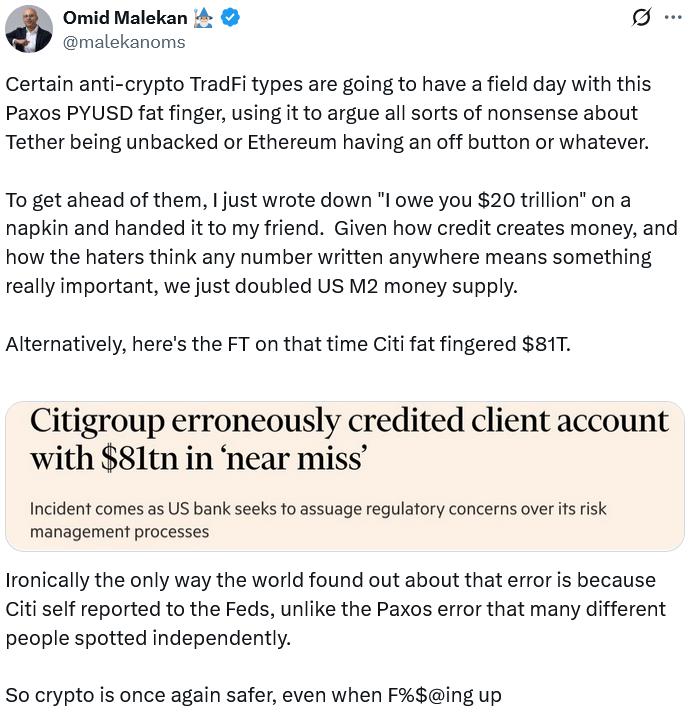
Banks Cover Up Mistakes, Crypto Platforms Keep Errors In Plain Sight
- Paxos mistakenly minted $300 trillion of PYUSD stablecoins, flagging the importance of operational controls. The blockchain's transparency allowed for rapid detection and removal of the erroneous tokens within minutes. This incident exemplifies how blockchain's openness could improve oversight in finance. Traditional banks have a history of costly“fat-finger” errors, often unnoticed for months. Experts see blockchain as a tool to enhance transparency and trust in financial transactions.
On October 15, Paxos issued an internal error that resulted in the creation of an unprecedented amount of PYUSD stablecoins-equivalent to approximately $300 trillion. The company quickly flagged the mistake, and the entire supply was burned within 22 minutes, demonstrating blockchain's ability to provide immediate visibility and swift corrective action.
Source: Ted Pillows
This incident starkly contrasts with traditional banking, where errors such as multi-billion dollar transfers can go unnoticed for months. For instance, in April 2024, Citigroup mistakenly credited $81 trillion to a client's account-a sum almost impossible to reconcile, which was only discovered and reversed after nearly 10 months. Similarly, other institutions have experienced multi-billion dollar errors with delayed disclosure, emphasizing the opacity and sluggish oversight in conventional finance.

Source: Omid Malekan A level of accountability“unheard of” in traditional banking
Blockchain advocates argue that this accident underscores one of the technology's greatest strengths: accountability. Ryne Saxe, CEO of the cross-chain stablecoin liquidity platform Eco, explains that the transparency demanded by blockchain creates a governance environment where mistakes can be not only identified in real time but also mitigate risks more effectively.
Lessons from banking's history of fat-finger errorsThese errors are not new; traditional banks have long been plagued with costly“fat-finger” mistakes. Deutsche Bank, for example, transferred €28 billion ($32.66 billion) to the wrong account in 2015, an error that took months to rectify. Citigroup's near-miss of transferring $6 billion to a wealth client also went unnoticed for a long period, illustrating the slow and opaque nature of the current system.
Such incidents, often only revealed long after they occur, demonstrate the limited accountability in conventional banking but stand in stark contrast to blockchain's instant visibility.
The Paxos incident as a“preventable mistake”Industry experts argue that Paxos' mistake, while significant, could have been avoided with tighter operational controls. Shahar Madar, VP of security at Fireblocks, emphasizes the importance of rigorous risk management and strict enforcement of token issuance policies for stablecoin providers.
“Minting $300 trillion is a preventable mistake. As stablecoins gain traction, issuers should ensure that security policies cover the entire token lifecycle-from minting to burning-and minimize manual interventions,” Madar said.
Given the rising importance of stablecoins and their growing role in the crypto economy, this event highlights the need for enhanced security measures that harness blockchain's transparency for better oversight and risk mitigation.
Crypto Investing Risk WarningCrypto assets are highly volatile. Your capital is at risk. Don't invest unless you're prepared to lose all the money you invest.
Legal Disclaimer:
MENAFN provides the
information “as is” without warranty of any kind. We do not accept
any responsibility or liability for the accuracy, content, images,
videos, licenses, completeness, legality, or reliability of the information
contained in this article. If you have any complaints or copyright
issues related to this article, kindly contact the provider above.
Most popular stories
Market Research

- Casper Network Advances Regulated Tokenization With ERC-3643 Standard
- Forex Expo Dubai Wins Guinness World Recordstm With 20,021 Visitors
- Superiorstar Prosperity Group Russell Hawthorne Highlights New Machine Learning Risk Framework
- Freedom Holding Corp. (FRHC) Shares Included In The Motley Fool's TMF Moneyball Portfolio
- Versus Trade Launches Master IB Program: Multi-Tier Commission Structure
- Ozzy Tyres Grows Their Monsta Terrain Gripper Tyres Performing In Australian Summers




















Comments
No comment